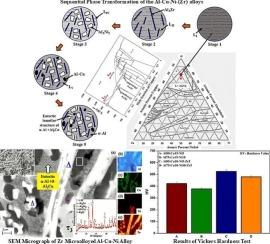铜模铸Al-Cu-Ni-(Zr)合金的序贯相演化:锆微合金化可获得超高硬度(~ 5 GPa)
IF 5.5
2区 材料科学
Q1 MATERIALS SCIENCE, CHARACTERIZATION & TESTING
引用次数: 0
摘要
本文研究了Al-Cu-Ni-(Zr)合金在电弧熔炼和铜模铸造过程中不同相的双峰组织演变过程。采用各种表征技术,包括x射线衍射、扫描电子和透射电子显微镜来研究微观结构特征。该研究通过将观察到的相与相应的三元相图和二元相图联系起来,提供了对相变基本原理的深入了解。结果表明,双峰组织和棒状Al3Zr的形成对合金的硬度有显著影响。值得注意的是,铜模铸Zr微合金Al80Cu15Ni5和Al75Cu15Ni10合金表现出不同寻常的高硬度(~ 5 GPa)。研究结果表明,双峰组织可以定制,以实现Al-Cu-Ni-(Zr)合金的优越力学性能,为先进工程应用的此类合金的显微组织设计提供了有价值的见解。本文章由计算机程序翻译,如有差异,请以英文原文为准。

Sequential phase evolution of copper mold cast Al-Cu-Ni-(Zr) alloys: Zirconium Micro-alloying results in ultrahigh hardness (∼5 GPa)
The present study reports the evolution of different phases with bimodal microstructure in Al-Cu-Ni-(Zr) alloys during arc melting followed by copper mold casting. Various characterization techniques, including X-ray diffractometry, scanning electron and transmission electron microscopy were employed to study the microstructural features. The study provides an insight into the fundamental of phase transformation by correlating the observed phases with the corresponding ternary and binary phase diagrams. The results demonstrate that the bimodal microstructure and the formation of rod-shaped Al3Zr significantly impact the hardness of the alloy. Noticeably, the copper mold cast Zr micro-alloyed Al80Cu15Ni5 and Al75Cu15Ni10 alloys exhibit unusual high hardness (∼5 GPa). The findings suggest that the bimodal microstructure can be tailored to achieve superior mechanical properties in Al-Cu-Ni-(Zr) alloys, providing valuable insights into the microstructural design of such alloys for advanced engineering applications.
求助全文
通过发布文献求助,成功后即可免费获取论文全文。
去求助
来源期刊

Materials Characterization
工程技术-材料科学:表征与测试
CiteScore
7.60
自引率
8.50%
发文量
746
审稿时长
36 days
期刊介绍:
Materials Characterization features original articles and state-of-the-art reviews on theoretical and practical aspects of the structure and behaviour of materials.
The Journal focuses on all characterization techniques, including all forms of microscopy (light, electron, acoustic, etc.,) and analysis (especially microanalysis and surface analytical techniques). Developments in both this wide range of techniques and their application to the quantification of the microstructure of materials are essential facets of the Journal.
The Journal provides the Materials Scientist/Engineer with up-to-date information on many types of materials with an underlying theme of explaining the behavior of materials using novel approaches. Materials covered by the journal include:
Metals & Alloys
Ceramics
Nanomaterials
Biomedical materials
Optical materials
Composites
Natural Materials.
 求助内容:
求助内容: 应助结果提醒方式:
应助结果提醒方式:


